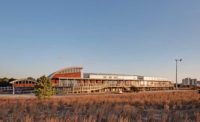
After nearly two years of operation to prove its worthiness, the 52,000-sq-ft Bullitt Center in Seattle—the first speculative office building to attempt full certification under the rigorous Living Building Challenge sustainability program—has been named a "living building." Last year, the six-story building, which is also the tallest living building, produced 60% more energy than it used.
"The next most efficient U.S. office I know of uses 50% more energy per sq ft than we do," says Denis Hayes, president of the Bullitt Foundation, which developed the $32.5-million project both to demonstrate "what's possible today and to pave a path forward" for other real estate developments. Hundreds of architects, developers, engineers, public officials and students have already visited the building, which opened on Earth Day, April 22, 2013.
Hayes is a current ENR Newsmaker for masterminding the small, but significant, office development, designed by a team led by the Miller Hull Partnership LLC and constructed by Schuchart. The Bullitt Foundation expects the building, currently 10% vacant, to be fully leased by May 1. The occupants will then number about 160.
The Living Building Challenge (LBC) is a program of the International Living Future Institute. ILFI, the Bullitt Foundation and the project's mechanical-electrical-plumbing engineer, PAE Consulting Engineers, are tenants in the building.
Launched in 2006, the LBC has more than 250 registered projects totaling more than 9 million sq ft of space. Certification is based on seven performance categories: place, water, energy, health and happiness, materials, equity and beauty.
Hayes says the energy, water and materials performance categories presented the biggest challenges to the building team. He commends the team's "brilliant problem-solving" and credits the tenants' energy-efficient equipment choices for the building's low energy use.
Capturing rainwater, purifying it and disposing of treated gray water onsite is not challenging technically but increases maintenance costs, says Hayes. But because public health is involved, water posed "by far" the greatest regulatory challenges, he adds.
It took two full "person-years" of work to eliminate 350 toxic materials from about 1,000 building components. Bullitt has posted its choices on its website to aid future living building developers—or anyone else.
The foundation, which is dedicated to supporting environmental sustainability, is hiring a program officer to lead a high-performance green-building program, designed to help others build on the Bullitt Center experience.



Post a comment to this article
Report Abusive Comment